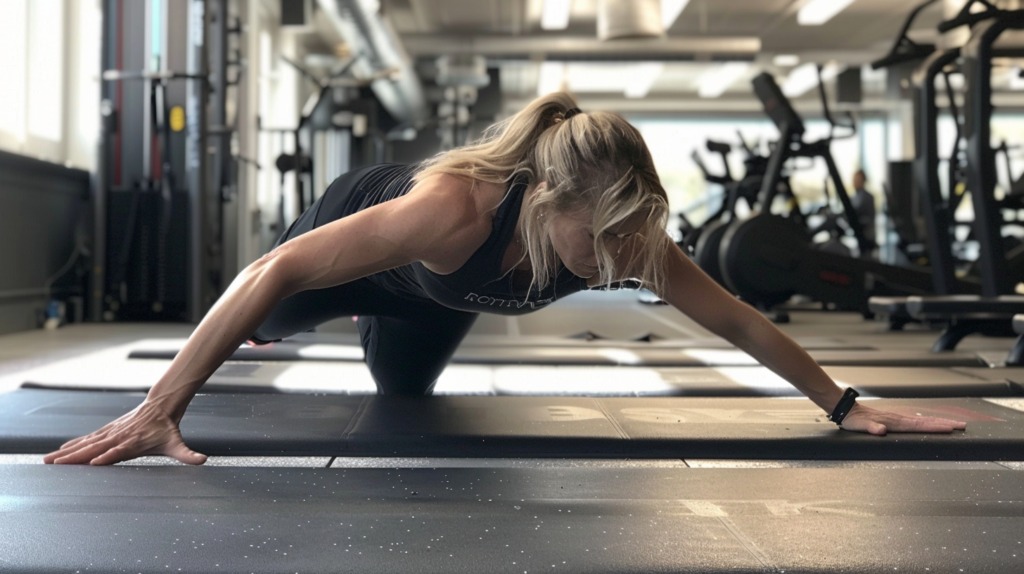Push-ups are a fantastic way to boost your upper body and core strength. They engage multiple muscle groups, making them effective for overall fitness. To do a push-up, place your hands slightly wider than shoulder-width, keeping your body in a straight line. Lower until your chest nearly touches the ground, keeping your elbows at a 45-degree angle. Remember to engage your core throughout the movement. You can modify the exercise to suit your level, from knee push-ups to more advanced variations. By incorporating them into your routine, you’ll see progress and build confidence. There’s much more to explore about mastering push-ups.
Key Takeaways
- Push-ups engage multiple muscle groups, enhancing upper body strength and core stability while promoting injury prevention and functional fitness.
- Proper form includes hand placement outside shoulder width, a straight body line, and core engagement throughout the movement.
- Common mistakes include improper hand and elbow positioning, lack of core engagement, and rushing through repetitions; focus on steady tempo.
- Variations like knee, incline, and decline push-ups cater to different fitness levels, allowing gradual strength progression.
- Incorporate push-ups into your routine 2-3 times a week, tracking progress to set benchmarks and maintain accountability through community support.
Benefits of Push-Ups
When it comes to bodyweight exercises, push-ups stand out for their numerous benefits. This fundamental movement engages multiple muscle groups, promoting overall strength and muscle activation. When you perform push-ups, you’re not just working your chest; your shoulders, triceps, and core are also getting a workout. This thorough engagement helps you build functional strength that translates into everyday activities.
Moreover, push-ups contribute greatly to injury prevention. By strengthening the muscles around your shoulders and stabilizing your core, you reduce the risk of injuries that can occur during other physical activities. A strong upper body and core support your posture, which is essential for avoiding strain and discomfort.
Incorporating push-ups into your routine can also enhance your endurance and boost your confidence. Each rep you complete is a step toward freedom from physical limitations.
You’ll start to feel more empowered in your body as you master this exercise. So, embrace the challenge of push-ups and reveal your potential. You’ve got this!
With consistent practice, you’ll not only see physical transformation but also gain a sense of achievement that fuels your journey toward a healthier, more liberated you.
Proper Push-Up Form

Mastering proper push-up form is essential for maximizing your results and preventing injury. When you focus on body alignment and muscle engagement, you empower yourself to perform push-ups effectively.
Here’s how to achieve the perfect form:
- Hand Placement: Position your hands slightly wider than shoulder-width apart. Your fingers should point forward or slightly outward.
- Body Alignment: Keep your body in a straight line from head to heels. Avoid sagging your hips or arching your back.
- Core Engagement: Engage your core muscles throughout the movement. This stabilizes your body and helps maintain proper alignment.
- Breathing Technique: Inhale as you lower yourself toward the ground and exhale as you push back up. This keeps your rhythm steady and efficient.
Common Mistakes to Avoid

Avoiding common mistakes during push-ups can make a significant difference in your performance and results.
First, pay attention to elbow positioning; keep them at a 45-degree angle from your body to protect your shoulders. Next, guarantee your hand placement is just outside shoulder width, which helps maintain proper alignment.
Core engagement is vital; a strong core stabilizes your body and supports good form.
Don’t forget about shoulder alignment—keep them down and away from your ears throughout the movement.
Breathing technique matters too; exhale as you push up and inhale as you lower down. This rhythm not only fuels your body but also enhances your mental focus.
Tempo control is essential; avoid rushing through your reps. Instead, aim for a steady pace that allows you to feel each movement.
Consistency is key, so establish a workout frequency that suits your level and goals.
Variations for Different Levels

For anyone looking to enhance their push-up routine, incorporating variations can cater to different fitness levels and goals.
Whether you’re just starting or you’re ready to challenge yourself, there’s a push-up variation for you. Here are four variations to take into account:
- Knee Push-Ups: Perfect for beginners, these reduce the weight you lift, helping you build strength gradually.
- Incline Push-Ups: Elevating your hands on a sturdy surface makes it easier than standard push-ups, allowing you to focus on form.
- Decline Push-Ups: Elevating your feet increases difficulty, targeting your upper chest and shoulders for advanced strength.
- Diamond Push-Ups: With your hands forming a diamond shape, this variation emphasizes your triceps, making it great for sculpting those arms.
As you become more comfortable, you might explore even more challenging options like wide grip, staggered hands, one arm push-ups, or plyometric push-ups.
For a fun twist, try clapping push-ups or spiderman push-ups to engage your core dynamically.
Embrace these variations, and watch your strength soar as you liberate your workout routine!
Incorporating Push-Ups Into Your Routine

After exploring various push-up variations, it’s time to think about how to fit them into your overall workout routine. Start by determining your push-up frequency. Aim for at least two to three sessions a week, allowing your body to adapt and strengthen.
You can integrate push-ups into different parts of your workout. For instance, include them in your warm-up to activate your muscles or as part of a circuit to keep your heart rate up.
Consider your fitness goals. If you’re focused on building endurance, you might want to perform higher repetitions with shorter rest periods. For strength, incorporate weighted push-ups or slower movements.
Remember, the key to effective workout integration is consistency. You can mix push-ups with other exercises like squats or lunges to create a balanced routine.
Don’t forget to listen to your body. If you feel fatigued, allow yourself time to recover.
Push-Ups for Strength and Endurance

Push-ups are a fantastic way to build both strength and endurance, making them a staple in any fitness regimen. By engaging multiple muscle groups, they help you develop a balanced physique while improving your overall fitness.
Incorporating push-ups into your routine can lead to remarkable results, especially when you focus on consistent workout frequency.
Here are four key benefits of push-ups for strength and endurance:
- Total Body Engagement: Push-ups activate your chest, shoulders, triceps, core, and even your legs, offering a thorough workout in one movement.
- Increased Muscle Endurance: Regular push-ups boost your muscles’ ability to sustain effort over time, allowing you to perform better in various physical activities.
- Adaptability: You can modify push-ups to suit your fitness level, helping you progress as you become stronger and more endurance-focused.
- Convenience: You can do them anywhere, anytime, making push-ups an accessible option for all.
Tips for Beginners

Starting your push-up journey can be exciting and rewarding, especially with the strength and endurance benefits they offer. As a beginner, it’s important to approach this exercise with the right mindset and techniques.
First, focus on your form. Start with your hands shoulder-width apart, keeping your body straight from head to heels. If a full push-up feels too challenging, consider modifying it by dropping to your knees.
Incorporating breathing techniques can greatly enhance your performance. Inhale as you lower your body and exhale as you push back up. This not only helps you maintain rhythm but also guarantees you’re engaging your core effectively.
Mental focus is vital, too. Visualize each movement and remind yourself of your goals, whether it’s building strength or improving endurance.
Break your push-up sets into manageable repetitions; you don’t have to do them all at once. Celebrate your progress, no matter how small, and stay patient with yourself.
Tracking Your Progress

Tracking your progress is essential for staying motivated and reaching your fitness goals. By monitoring your journey, you not only celebrate your accomplishments but also identify areas for improvement.
Here are four effective ways to keep track of your push-up progress:
- Progress Journals: Document your sets, reps, and feelings after each workout. This will help you see patterns and growth over time.
- Performance Benchmarks: Set specific goals, like increasing your push-up count or improving your form. Regularly test yourself to measure your performance against these benchmarks.
- Visual Tracking: Use charts or graphs to visualize your progress. Seeing your improvements visually can be incredibly motivating and encouraging.
- Accountability Partners: Share your goals with a friend or join a community. Having someone to share your journey with can provide motivation and support.
Frequently Asked Questions
Can Push-Ups Help With Weight Loss?
Absolutely, push-ups can aid in weight loss by increasing your caloric burn. They’re a powerful form of strength training, helping you build muscle while boosting metabolism, making your fitness journey both rewarding and liberating.
How Many Push-Ups Should I Do Daily?
Imagine you’re a knight training for battle. To conquer your daily goals, start with 10 push-ups and gradually increase. Experiment with push-up variations to keep it fresh, and soon you’ll feel empowered and strong!
Are Push-Ups Safe for Pregnant Women?
Yes, push-ups can be safe for pregnant women when modified appropriately. Incorporate push-up modifications into your prenatal fitness routine to maintain strength while ensuring comfort. Always listen to your body and consult your healthcare provider.
Do Push-Ups Improve Posture?
Yes, push-ups improve posture by promoting core engagement and strengthening upper body muscles. Incorporating push-up variations challenges your body, enhancing stability and alignment. You’ll feel empowered as you develop better posture and overall strength!
Can Push-Ups Lead to Muscle Imbalances?
Yes, push-ups can lead to muscle imbalances if you don’t vary your routine. Ignoring different muscle groups may cause muscle fatigue and affect joint stability, so mix in other exercises for balanced strength and liberation.
Conclusion
Incorporating push-ups into your routine can be like planting seeds in a garden—each rep nurtures strength and endurance, blossoming into a fitter you. By mastering your form, avoiding common pitfalls, and exploring variations, you’ll not only challenge your body but also empower your spirit. Remember, every push-up is a step towards your goals. So, roll out that mat, embrace the sweat, and watch your progress flourish as you build a stronger, more resilient self.













